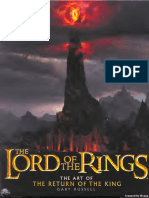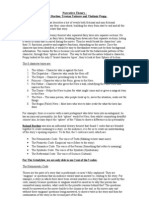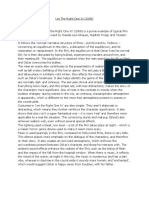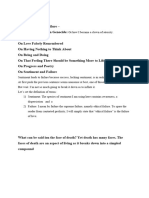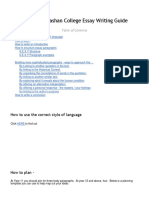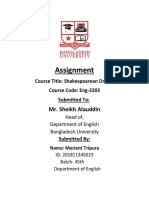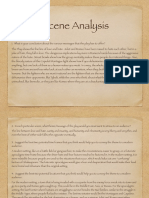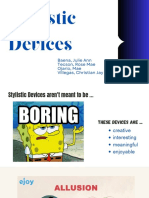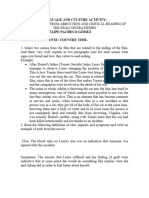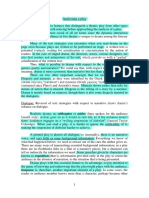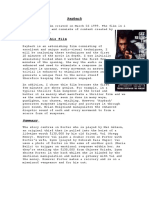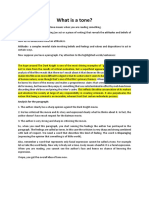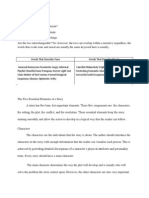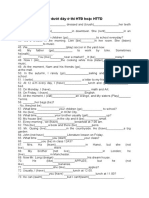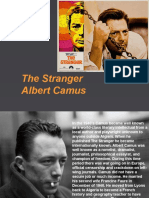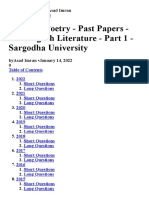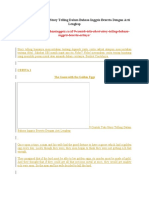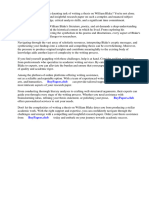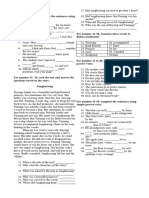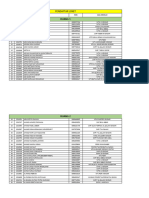0 ratings0% found this document useful (0 votes)
16 viewsGeneric Conventions
Generic Conventions
Uploaded by
ZoiaThe document discusses generic conventions commonly found in thriller films, including characteristics of lighting, sound, music, and characters. Specifically, it notes that lighting in thrillers is often desaturated or uses high contrast to create mood and tension. The sound and music can be either diegetic or non-diegetic and is meant to be synchronous with the images. Character types in thrillers generally include protagonists, antagonists, and characters that fit Joseph Propp's roles like the hero, villain, donor, and princess.
Copyright:
© All Rights Reserved
Available Formats
Download as DOCX, PDF, TXT or read online from Scribd
Generic Conventions
Generic Conventions
Uploaded by
Zoia0 ratings0% found this document useful (0 votes)
16 views1 pageThe document discusses generic conventions commonly found in thriller films, including characteristics of lighting, sound, music, and characters. Specifically, it notes that lighting in thrillers is often desaturated or uses high contrast to create mood and tension. The sound and music can be either diegetic or non-diegetic and is meant to be synchronous with the images. Character types in thrillers generally include protagonists, antagonists, and characters that fit Joseph Propp's roles like the hero, villain, donor, and princess.
Original Title
GCT
Copyright
© © All Rights Reserved
Available Formats
DOCX, PDF, TXT or read online from Scribd
Share this document
Did you find this document useful?
Is this content inappropriate?
The document discusses generic conventions commonly found in thriller films, including characteristics of lighting, sound, music, and characters. Specifically, it notes that lighting in thrillers is often desaturated or uses high contrast to create mood and tension. The sound and music can be either diegetic or non-diegetic and is meant to be synchronous with the images. Character types in thrillers generally include protagonists, antagonists, and characters that fit Joseph Propp's roles like the hero, villain, donor, and princess.
Copyright:
© All Rights Reserved
Available Formats
Download as DOCX, PDF, TXT or read online from Scribd
Download as docx, pdf, or txt
0 ratings0% found this document useful (0 votes)
16 views1 pageGeneric Conventions
Generic Conventions
Uploaded by
ZoiaThe document discusses generic conventions commonly found in thriller films, including characteristics of lighting, sound, music, and characters. Specifically, it notes that lighting in thrillers is often desaturated or uses high contrast to create mood and tension. The sound and music can be either diegetic or non-diegetic and is meant to be synchronous with the images. Character types in thrillers generally include protagonists, antagonists, and characters that fit Joseph Propp's roles like the hero, villain, donor, and princess.
Copyright:
© All Rights Reserved
Available Formats
Download as DOCX, PDF, TXT or read online from Scribd
Download as docx, pdf, or txt
You are on page 1of 1
Lighting: Since a
movie thats in the
The narrative follows
Thriller genre
Todorovs Theory of
The
type
of
characters
intention is to
Narrative, which is
in
Thrillers,
correspond
scare/thrill the
described as
to
Propps
Theory
of
audience. The
1. A state of balance
Binary opposites: of
Narrative.
This
includes
lighting
would be
as the beginning
Sound/Music:
Thrillers
can
the antagonist
and
The
Hero,
the
villain,
the
de-saturated
point
include both
diegeticorand
protagonist.
donor,
the
helper,
the
extreme
in some
2. Something
non-diegetic
sound,
Protagonists
are
princess,
the
dispatcher
way, to match the
happens that disrupts
usually
favoured into
non-diegetic
and the false hero. especially
mood of the film. A
the balance or okaycomparison
to
mystery
Obviously, Thrillers add tension
goodand
example
of to
ness of the situation.
antagonists.
Unless
movies have developed
the narrative.
The be
sound
this would
in the
3. Someone sees that
theyre anti-heroes,
enough
to
overpass
this,
would also
usually
film
sin city,be
lowsomething has
which show that even
and
are
usually
vary
in
key lighting
is
happened; address
synchronous
to the who
images.
protagonists
the
type
of
characters
used. Since
the
the problem.
While it appear
would
also
be
to
have
villainthey
have.
majority
of
the
4. They attempt to
parallel, it can also use
scenes are done in
repair the damage
contrapuntal
in the
high contrast
GENERIC CONVENTIONS
beginning
to givethe
false
lighting,
bright
safety. Orlighting
it can helps
be done
put in
thrillers-comedies
for a
emphasis on
comedic certain
effect, details.
especially if
You might also like
- The Art of The Return of The KingDocument118 pagesThe Art of The Return of The KingPedro Henrique PizzolottoNo ratings yet
- How Narrator's Unreliability Is Hinted and Hidden in Fight ClubDocument7 pagesHow Narrator's Unreliability Is Hinted and Hidden in Fight ClubArianna Ramone100% (1)
- Genre Research - ThrillerDocument2 pagesGenre Research - ThrillerTobi DrunkforChrist OdeleyeNo ratings yet
- Understand Codes and Convention of Fictional Film Production Section 1 - NarrativeDocument20 pagesUnderstand Codes and Convention of Fictional Film Production Section 1 - NarrativeChalloner MediaNo ratings yet
- Narrative TheoryDocument3 pagesNarrative Theorygulab_nawab_1No ratings yet
- Let The Right One inDocument3 pagesLet The Right One inAlex WilsonNo ratings yet
- Genre Research - ThrillerDocument2 pagesGenre Research - ThrillerTobi DrunkforChrist OdeleyeNo ratings yet
- Evaluation: in What Ways Does Your Media Product Use, Develop or Challenge Forms and Conventions of Real Media Products?Document12 pagesEvaluation: in What Ways Does Your Media Product Use, Develop or Challenge Forms and Conventions of Real Media Products?oscarzeNo ratings yet
- EssaysDocument12 pagesEssays2vvr4crwsyNo ratings yet
- Generic SignifiersDocument23 pagesGeneric SignifierssteviepellcvhsNo ratings yet
- Essay Writing Guide Building More Sophisticated Paragraphs - Ways To Approach This ...Document10 pagesEssay Writing Guide Building More Sophisticated Paragraphs - Ways To Approach This ...Mārïę NākåørãNo ratings yet
- Natasha BlockleyDocument5 pagesNatasha BlockleyNatasha BlockleyNo ratings yet
- Real Media TextsDocument6 pagesReal Media Textsapi-243834900No ratings yet
- GothicDocument11 pagesGothicMaite PonceNo ratings yet
- MonologusDocument6 pagesMonologusAGLIN ROSEBINONo ratings yet
- Literary Elements - Definitions and ExamplesDocument9 pagesLiterary Elements - Definitions and Examplesapi-339254566No ratings yet
- Genre ResearchDocument2 pagesGenre ResearchdanielleconneelyNo ratings yet
- Poly Aaisngmentffff PDFDocument20 pagesPoly Aaisngmentffff PDFMd Saidul IslamNo ratings yet
- Romeo and Juliet Production BinderDocument16 pagesRomeo and Juliet Production Binderapi-300372515No ratings yet
- Genre ResearchDocument2 pagesGenre ResearchdanielleconneelyNo ratings yet
- Genre Hybrids EssayDocument4 pagesGenre Hybrids EssayAleksandra AndraNo ratings yet
- A2 MediaDocument17 pagesA2 Mediaapi-239410729No ratings yet
- Let Me inDocument2 pagesLet Me inYancia JenciNo ratings yet
- Drama HanaaaDocument6 pagesDrama Hanaaaasep rohmanaNo ratings yet
- Narrative Structure: Ben Bateman 12pDocument3 pagesNarrative Structure: Ben Bateman 12pbenbateman1717No ratings yet
- Stylistic Devices: Baena, Julie Ann Tecson, Rose Mae Ojario, Mae Villegas, Christian JayDocument46 pagesStylistic Devices: Baena, Julie Ann Tecson, Rose Mae Ojario, Mae Villegas, Christian JayRose Mae TecsonNo ratings yet
- Author's PurposeDocument16 pagesAuthor's PurposeMa Donna GeroleoNo ratings yet
- Part FiveDocument6 pagesPart Fiveebun_ewedemiNo ratings yet
- Updated Previous Case Study For Narrative Chapter: Psycho (Us 1960)Document9 pagesUpdated Previous Case Study For Narrative Chapter: Psycho (Us 1960)Nishi SoniNo ratings yet
- JinrohreviewDocument5 pagesJinrohreviewapi-266685207No ratings yet
- Once Upon A Time in AmericaDocument11 pagesOnce Upon A Time in AmericaaliciarnoldNo ratings yet
- Leon - Poster Analysis (1&2&3)Document25 pagesLeon - Poster Analysis (1&2&3)LeonNo ratings yet
- Elements Techniques and Literary Devices in Drama 1Document5 pagesElements Techniques and Literary Devices in Drama 1Zekenari Ci0% (1)
- PitchDocument6 pagesPitchJack DreyerNo ratings yet
- Compare and Contrast RJ To WSSDocument3 pagesCompare and Contrast RJ To WSSMrs. P100% (1)
- Cms 320 Journal TwoDocument12 pagesCms 320 Journal Twoapi-522855390100% (1)
- Unit Ii: Fiction Writing Practice ActivityDocument2 pagesUnit Ii: Fiction Writing Practice ActivityJesusaNo ratings yet
- Analysis of The Movie ContratiempoDocument5 pagesAnalysis of The Movie ContratiempoScribdTranslationsNo ratings yet
- Analysing A PlayDocument9 pagesAnalysing A PlayCristina SerranoNo ratings yet
- GED11 - 14. DramaDocument6 pagesGED11 - 14. DramaKyle CepilloNo ratings yet
- Why I Chose This Film: PaybackDocument8 pagesWhy I Chose This Film: PaybackkeivanNo ratings yet
- What Is A Tone?: Tone:-The Quality of Something (An Act or A Piece of Writing) That Reveals The Attitudes and Beliefs ofDocument1 pageWhat Is A Tone?: Tone:-The Quality of Something (An Act or A Piece of Writing) That Reveals The Attitudes and Beliefs ofchaostheoristNo ratings yet
- Characteristics of Prose and Drama - EL115Document11 pagesCharacteristics of Prose and Drama - EL115Ivy Ybanez100% (1)
- MonologueDocument4 pagesMonologueRj MarcelinoNo ratings yet
- Conventions + Sub GnenreDocument7 pagesConventions + Sub GnenreKareemtamamNo ratings yet
- What's My Genre?: The Single Most Important Decision You Must Make When Developing YourDocument16 pagesWhat's My Genre?: The Single Most Important Decision You Must Make When Developing YourpradeepNo ratings yet
- Elements of Literature in The Cask of Amontillado - Courtney KamlerDocument4 pagesElements of Literature in The Cask of Amontillado - Courtney KamlerDrake Man100% (1)
- Narratology - A Guide To The Theory of NarrativeDocument81 pagesNarratology - A Guide To The Theory of NarrativeSujatha Menon100% (1)
- Out of Sight and The Self Reflexive 90's CinemaDocument14 pagesOut of Sight and The Self Reflexive 90's CinemaTalha Farooqi100% (1)
- Film Genre PDFDocument24 pagesFilm Genre PDFclowningmonthbegins100% (1)
- The Insane Final Ting.Document2 pagesThe Insane Final Ting.simziieNo ratings yet
- Inglorious Bastards EssayDocument4 pagesInglorious Bastards Essaylaura_ward01100% (1)
- Deuteragonist in LiteratureDocument3 pagesDeuteragonist in LiteratureYor ForgerNo ratings yet
- About Time AnisaDocument23 pagesAbout Time Anisaapi-238878443No ratings yet
- Thriller Film AnalysisDocument5 pagesThriller Film Analysisapi-295389685No ratings yet
- What Is A ThrillerDocument5 pagesWhat Is A Thrillerjodieoneill_6No ratings yet
- The Five Essential Elements of A StoryDocument4 pagesThe Five Essential Elements of A Storypapa_tigreNo ratings yet
- Play & Story ElementsDocument7 pagesPlay & Story Elementsabdullahharoonabbasi13100% (1)
- Kayleigh FinalDocument12 pagesKayleigh FinalChalloner MediaNo ratings yet
- Bài 2. Chia động từ dưới đây ở thì HTĐ hoặc HTTDDocument2 pagesBài 2. Chia động từ dưới đây ở thì HTĐ hoặc HTTDOanh Chi NguyễnNo ratings yet
- The StrangerDocument8 pagesThe StrangerAlda DomicNo ratings yet
- Isversta Menshikova K. Runyi I Bogi Drevnie Sakr.a6-Part-2Document202 pagesIsversta Menshikova K. Runyi I Bogi Drevnie Sakr.a6-Part-2inguliukas1100% (1)
- Classical PoetryDocument8 pagesClassical PoetryMr.Cournelious LiaqatNo ratings yet
- Shan e Siddiq e AkbarDocument29 pagesShan e Siddiq e AkbarjafferrafiqNo ratings yet
- Elmer and The Stranger EnglishareDocument20 pagesElmer and The Stranger EnglisharePatricia Latrelle100% (1)
- 4 English A PDFDocument3 pages4 English A PDFAVANEESH CHINIWALNo ratings yet
- Reconstructive Postmodernism, Quotation and Musical Analysis. Luciano Berio's SinfoniaDocument291 pagesReconstructive Postmodernism, Quotation and Musical Analysis. Luciano Berio's SinfoniaFedericoNo ratings yet
- TheatreDocument6 pagesTheatreStefanie Kylle UsmanNo ratings yet
- Introduction To The Akkadian LanguageDocument10 pagesIntroduction To The Akkadian LanguageBBDNo ratings yet
- Sandy Petersenx27s Cthulhu Mythos v8 Compress (001 148)Document148 pagesSandy Petersenx27s Cthulhu Mythos v8 Compress (001 148)kirito 83100% (2)
- BHS Inggris XiDocument3 pagesBHS Inggris Xitrisno riyantoNo ratings yet
- Spot 1&2 Master Cue Sheet - Oliver! - C02 - Cueing PDFDocument4 pagesSpot 1&2 Master Cue Sheet - Oliver! - C02 - Cueing PDFJoel McKenzie100% (1)
- English FAL P3 Nov 2022 MGDocument12 pagesEnglish FAL P3 Nov 2022 MGthulilemngadi93No ratings yet
- 9 Contoh Teks Cerita Story Telling Dalam Bahasa Inggris Beserta Dengan Arti LengkapDocument12 pages9 Contoh Teks Cerita Story Telling Dalam Bahasa Inggris Beserta Dengan Arti Lengkapanisaeka panNo ratings yet
- MAEG09Document329 pagesMAEG09muhammad faheemNo ratings yet
- Research Paper William BlakeDocument8 pagesResearch Paper William Blakeefjem40q100% (1)
- English Exercise For Test For Grade 9Document1 pageEnglish Exercise For Test For Grade 9eliamran82No ratings yet
- Little Red Riding HoodDocument3 pagesLittle Red Riding HoodAyauly NussipakynNo ratings yet
- John Keats Research Paper TopicDocument8 pagesJohn Keats Research Paper Topicafnhfbgwoezeoj100% (1)
- Memory and Imagination - Patricia HamplDocument19 pagesMemory and Imagination - Patricia HamplHaseeb Ahmed ShaikhNo ratings yet
- Shakespearean ComedyDocument1 pageShakespearean ComedyKOUSIK BISWASNo ratings yet
- The Sufi Path of Love - The Spiritual Teachings of Rumi (By W. C. Chittick)Document912 pagesThe Sufi Path of Love - The Spiritual Teachings of Rumi (By W. C. Chittick)Mohammed Salih100% (11)
- Fic Masterlist by @whippedkimDocument8 pagesFic Masterlist by @whippedkimmyuu fufufuNo ratings yet
- 1 Jalebis LessonDocument13 pages1 Jalebis LessonATUL KUMAR SINGHNo ratings yet
- Verlain La Bonne Chanson - TekstDocument27 pagesVerlain La Bonne Chanson - Tekstmmarriuss7No ratings yet
- Lesson 1: Nature and Meaning of Literature: 21 Century Literature From The Philippines and The WorldDocument8 pagesLesson 1: Nature and Meaning of Literature: 21 Century Literature From The Philippines and The WorldGillian Caingat LicuananNo ratings yet
- Pengumuman BerkasDocument31 pagesPengumuman BerkasCahya NabilaNo ratings yet
- Clean SlatesDocument2 pagesClean SlatesEthan SzadkowskiNo ratings yet
